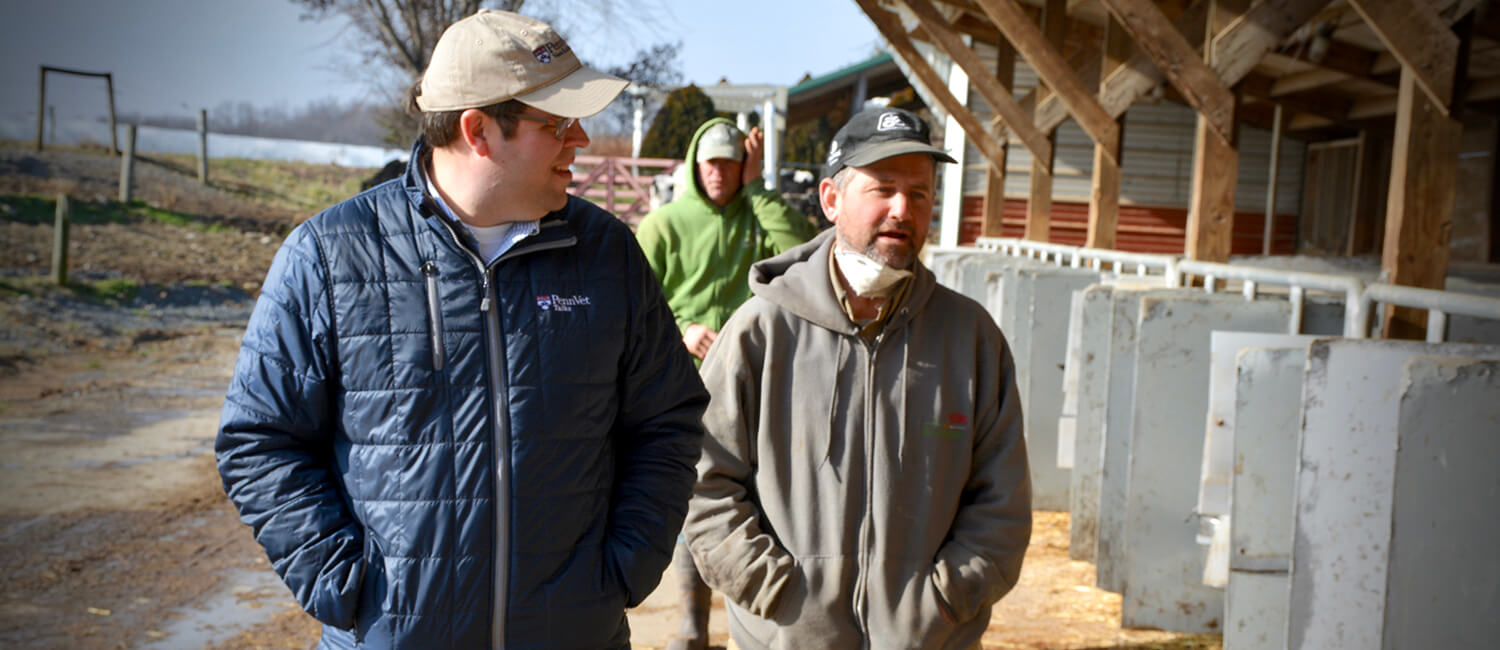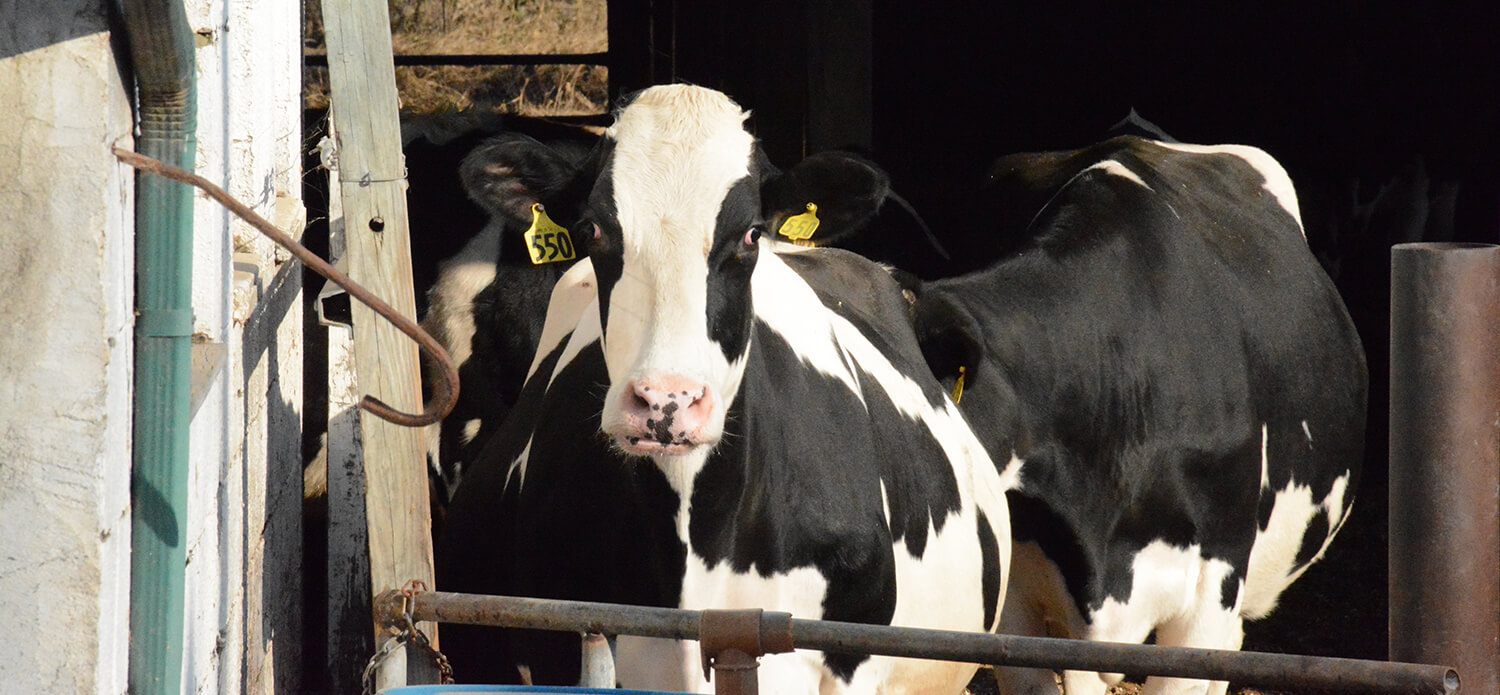 (Counterclockwise, left to back): Veterinarian Dr. Joseph Bender and farmers Jim and Joey Hertzler at Summit Level farm,
(Counterclockwise, left to back): Veterinarian Dr. Joseph Bender and farmers Jim and Joey Hertzler at Summit Level farm,
where Bender checks on the farm’s health and well-being.
On one of the first bitter cold December mornings last fall, Dr. Joe Bender’s workday started at Summit Level farm, a nearly 100-year-old dairy owned and run by Jim and Joey Hertzler. The brothers are regular clients of Bender and the Penn Vet Center for Animal Health and Productivity (CAHP).
Located in Elverson, Pennsylvania, the farm supports three families with 100 Holsteins; it’s one of the most successful dairies of its size in Pennsylvania. But never ones to rest on success, the Hertzlers are always considering areas to refine. CAHP, which Penn Vet established in 1986 as a teaching, research, and service initiative to improve health and productivity in food animal herds and flocks, has become a regular go-to resource for them.
“We used to bring in dairy consultants. They’d get to the farm and would ask, ‘Why do you want to do better? Your cows are fine. Your business is doing well. You’re in the top 10 percent of Pennsylvania herds. Just leave it alone,’” said Joey.
The consultants’ laissez-faire attitude didn’t sit well with the Hertzlers and it doesn’t satisfy Bender, Assistant Professor of Clinical Dairy Production Medicine at New Bolton Center, whom the farmers first met nearly eight years ago. “CAHP’s philosophy is that you never stop trying to do or get better,” he said. “There is always an opportunity to improve some aspect of the dairy, either animal performance, health, or environment, or, maybe most importantly, the health of the entire farm.”
From Top 10 Percent to Top One Percent
The Hertzlers’ farm, Bender said, is a model—the herd averages 105 pounds of milk per cow per day, where an average Pennsylvania herd makes 70 pounds. It’s not by accident. “Jim and Joey’s openness to troubleshooting issues and continually looking for opportunities to do better is what puts them now in the top one percent of Pennsylvania farms with fewer than 200 cows,” he said. “Every year, we bring students out here to understand successful production.”
The Hertzlers first got to know Bender while he was on staff at a private veterinary practice. In 2012 several of Summit Level’s cows were retaining placentas after giving birth, which can lead to infection and can seriously decrease milk production. Bender was their veterinarian.
“You could have taken two approaches to a situation like this,” Bender said. “One would be to put the cows on antibiotics, which is the more traditional veterinary medicine approach: The cow is broken, let’s fix it. But there are also more systematic changes we can make to preventing and solving problems. In this case, a protein deficiency was contributing to the retained placentas. We adjusted the feed and the problem went away.”
For this insight into the cows’ nutrition, Bender had consulted with Penn Vet’s Dr. Linda Baker, Associate Professor of Clinical Dairy Production Medicine. She helped analyze and adjust the cows’ diet.

Asking and Answering Different Questions
Over time, Bender noticed more often the farms he served needed the type of expertise CAHP and the School provided more than direct clinical care for individual cows. He left private practice to join the faculty of Penn Vet in 2014.
“The questions I was starting to get from producers were beyond the scope of what I could do as a traditional veterinarian, and I wasn’t finding solutions in private practice to helping make smaller farms sustainable,” he explained.
Bender is now Baker’s colleague. The two of them work with approximately 14,000 cows across 32 clients or herds statewide. (This doesn’t include herds the pair interacts with for research projects or on their students’ dairy production medicine rotations.)
“On a normal week, I’m in the office for two days and ‘on farm’ the other three days,” Bender said. “This has been the trend for the past two years. Before that, a typical week was one or two farm visits per week and three to four days of office time. The state of the dairy industry and demand for CAHP services has resulted in my spending more time on farms.”
Eyes Wide Open
During his December 2018 Summit Level visit, Bender, walked the land with Joey and Jim, visiting with calves and dry and lactating cows. “I have my eyes open when on the farm—I’m looking at the hay or bedding or feed.”
Bender observed the animals, asking the brothers a question here or there. “When I’m out here, we always talk about how the cows are milking and how the brothers are doing. We’ve had a lot of rain recently. Is that affecting anything? And what can we do to keep it from impacting the animals? It’s less about individual animals but the herd as a whole.”
In addition to observing herd health and well-being, he considers, along with the Hertzlers, where they might safely maximize profits and cut costs.
“We’re always chasing something,” said Bender. “For example, calf grain and the cost of it. If you find something you like and use it, should we go back and reevaluate it? Yes! We feed a lot of calves. If it’s $400 a ton for feed and we look at some different formulations, maybe we can do it for $375 and still keep the calves healthy. Over a year this really adds up for farmers, who have very slim margins.”
Tracking Productivity with Technology
Site visits and personal client consultations are only part of Bender’s CAHP toolbox. The center also offers access, through software, to an analytical take on issues affecting producers, locally and globally.
CAHP’s Production/Reproduction Monitor imports data captured on and from farms, which CAHP staff use to analyze and monitor herd performance. “This package is our main tool for troubleshooting production or health-related issues for new clients,” Bender said.
The UPenn Dairy Ration Analyzer is a subscription-based program for evaluating and formulating dairy cattle feed rations. Developed to maximize animal production and health, it also minimizes environmental impact and provides optimal cost efficiency insight to users.
A suite of online visual analytics, available to the dairy industry, can also help with decision making on farms. “This package enables comparisons of different on-farm scenarios or the use of actual farm data to make an informed economic decision, rather than leaving us to guess or ‘do what we’ve always done,’” said Bender. “It also benchmarks different parameters and shows how farms compare to other similar-sized farms.”
Healthy Cows, Healthy People
After visiting with the cows and reminiscing about eight years of challenges, successes, and collaboration, Jim, Joey, and Bender move inside to escape the cold and review records.
The three have an easy comradery, like friends with a shared mission. “Joe [Bender] cares about our cows. He cares about our farm,” said Jim.
It’s a process and relationship Bender appreciates. His work, he said, is as much about the people on the farm as it is with the cows. “If the farm is healthy, not just the animals, but the entire farm, then almost always the people associated with the farm will also be healthy. Ultimately the people connected to the farm are what we truly care about.”